Transport Layer : TCP Connection
TCP is connection-oriented. A connection-oriented transport protocol establishes a virtual path between the source and destination. All the segments belonging to a message are then sent over this virtual path.
Using a single virtual pathway for the entire message facilitates the acknowledgment process as well as retransmission of damaged or lost frames. How TCP, which uses the services of IP, a connectionless protocol, can be connection-oriented. The point is that a TCP connection is virtual, not physical.
TCP operates at a higher level. TCP uses the services of IP to deliver individual segments to the receiver, but it controls the connection itself. If a segment is lost or corrupted, it is retransmitted. Unlike TCP, IP is unaware of this retransmission. If a segment arrives out of order, TCP holds it until the missing segments arrive; IP is unaware of this reordering.
In TCP, connection-oriented transmission requires three phases: connection estab- lishment, data transfer, and connection termination :
Connection Establishment : TCP transmits data in full-duplex mode. When two TCPs in two machines are con- nected, they are able to send segments to each other simultaneously. This implies that each party must initialize communication and get approval from the other party before any data are transferred.
Three - Way Handshaking : The connection establishment in TCP is called threeway handshaking. In our example, an application program, called the client, wants to make a connection with another application program, called the server, using TCP as the transport layer protocol.
The process starts with the server. The server program tells its TCP that it is ready to accept a connection. This is called a request for a passive open. Although the server TCP is ready to accept any connection from any machine in the world, it cannot make the connection itself.
The client program issues a request for an active open. A client that wishes to connect to an open server tells its TCP that it needs to be connected to that particular server.
Connection establishment using three-way handshaking
The client sends the first segment, a SYN segment, in which only the SYN flag is set. This segment is for synchronization of sequence numbers. It consumes one sequence number. When the data transfer starts, the sequence number is incremented by 1. We can say that the SYN segment carries no real data, but we can think of it as containing 1 imaginary byte.
The server sends the second segment, a SYN + ACK segment, with 2 flag bits set: SYN and ACK. This segment has a dual purpose. It is a SYN segment for commu- nication in the other direction and serves as the acknowledgment for the SYN segment. It consumes one sequence number.
The client sends the third segment. This is just an ACK segment. It acknowledges the receipt of the second segment with the ACK flag and acknowledgment number field. Note that the sequence number in this segment is the same as the one in the SYN segment; the ACK segment does not consume any sequence numbers.
SYN Flooding Attack : This happens when a malicious attacker sends a large number of SYN segments to a server, pretending that each of them is corning from a different client by faking the source IP addresses in the datagrams.
The server, assuming that the clients are issuing an active open, allocates the necessary resources, such as creating communication tables and setting timers. The TCP server then sends the SYN + ACK segments to the fake clients, which are lost. During this time, however, a lot of resources are occupied without being used.
If, during this short time, the number of SYN segments is large, the server eventually runs out of resources and may crash. This SYN flooding attack belongs to a type of security attack known as a denial-of-service attack, in which an attacker monopolizes a system with so many service requests that the system collapses and denies service to every request.
Some implementations of TCP have strategies to alleviate the effects of a SYN attack. Some have imposed a limit on connection requests during a specified period of time. Others filter out datagrams corning from unwanted source addresses.
One recent strategy is to postpone resource allocation until the entire connection is set up, using what is called a cookie. SCTP, the new transport layer protocol uses this strategy.
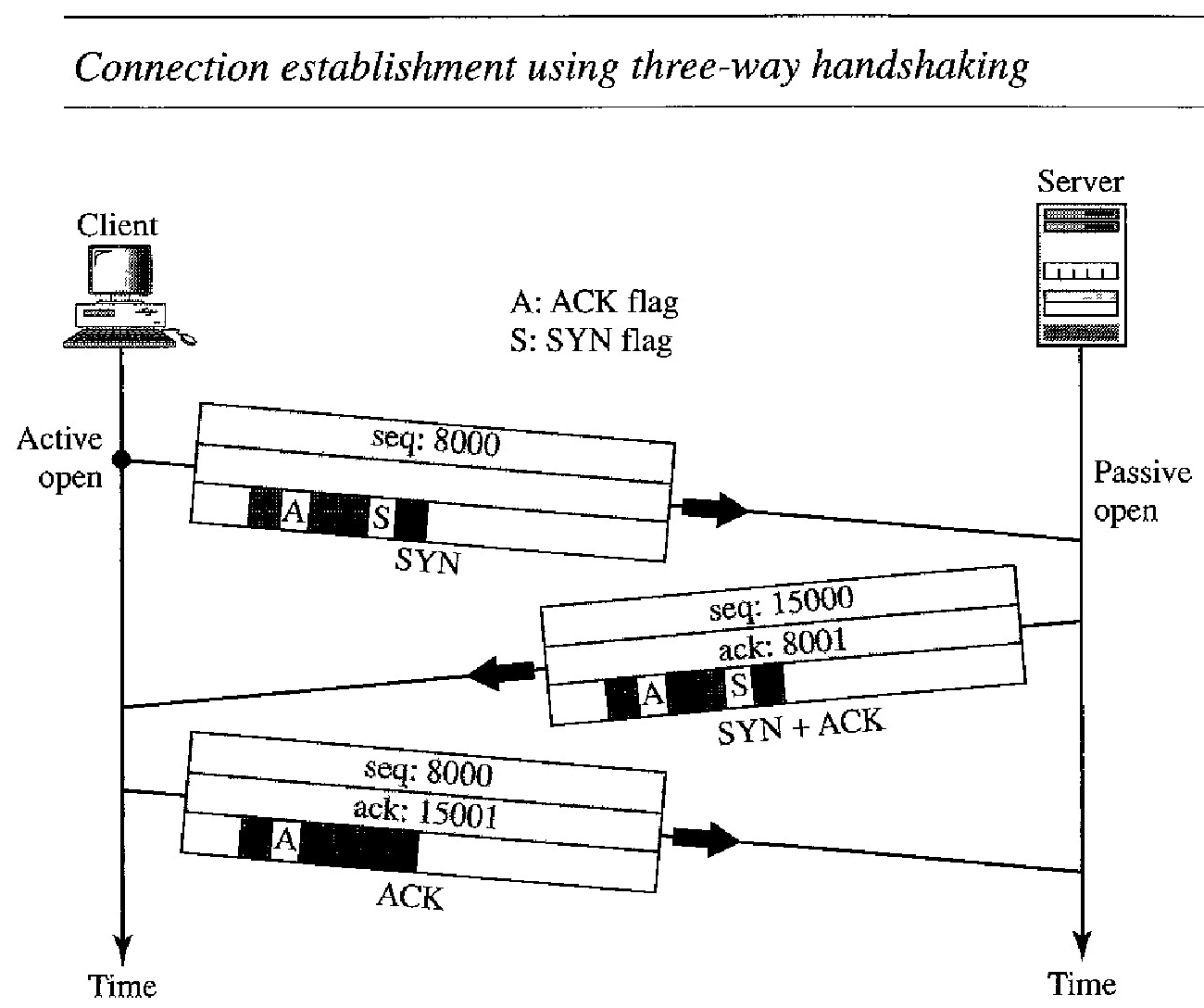
Data Transfer
After connection is established, bidirectional data transfer can take place. The client and server can both send data and acknowledgments.
Data traveling in the same direction as an acknowledgment are carried on the same segment. The acknowledgment is piggybacked with the data.
Figure below shows an example after connection is established (not shown in the figure), the client sends 2000 bytes of data in two segments. The server then sends 2000 bytes in one segment. The client sends one more segment. The first three segments carry both data and acknowledgment, but the last segment carries only an acknowledgment because there are no more data to be sent.
Note the values of the sequence and acknowledgment numbers. The data segments sent by the client have the PSH (push) flag set so that the server TCP knows to deliver data to the server process as soon as they are received. The segment from the server, on the other hand, does not set the push flag. Most TCP implementations have the option to set or not set this flag.
Pushing Data : We saw that the sending TCP uses a buffer to store the stream of data coming from the sending application program. The sending TCP can select the segment size. The receiving TCP also buffers the data when they arrive and delivers them to the application program when the application program is ready or when it is convenient for the receiving TCP. This type of flexibility increases the efficiency of TCP.
However, on occasion the application program has no need for this flexibility. For example, consider an application program that communicates interactively with another application program on the other end. The application program on one site wants to send a keystroke to the application at the other site and receive an immediate response. Delayed transmission and delayed delivery of data may not be acceptable by the application program.
TCP can handle such a situation. The application program at the sending site can request a push operation. This means that the sending TCP must not wait for the window to be filled. It must create a segment and send it immediately. The sending TCP must also set the push bit (PSH) to let the receiving TCP know that the segment includes data that must be delivered to the receiving application program as soon as possible and not to wait for more data to come.
Although the push operation can be requested by the application program, most current implementations ignore such requests. TCP can choose whether or not to use this feature.
TCP Connection Termination
Any ofthe two parties involved in exchanging data (client or server) can close the connec- tion, although it is usually initiated by the client. Most implementations today allow two options for connection termination: three-way handshaking and four-way handshaking with a half-close option.
Three-Way Handshaking : Most implementations today allow three-way handshaking for connection termination as shown
In a normal situation, the client TCP, after receiving a close command from the client process, sends the first segment, a FIN segment in which the FIN flag is set. Note that a FIN segment can include the last chunk of data sent by the client, or it can be just a control segment. If it is only a control segment, it consumes only one sequence number.
The server TCP, after receiving the FIN segment, informs its process of the situation and sends the second segment, a FIN + ACK segment, to confirm the receipt of the FIN segment from the client and at the same time to announce the closing of the connection in the other direction. This segment can also contain the last chunk of data from the server. If it does not carry data, it consumes only one sequence number.
The client TCP sends the last segment, an ACK segment, to confirm the receipt of the FIN segment from the TCP server. This segment contains the acknowledgment number, which is 1 plus the sequence number received in the FIN segment from the server. This segment cannot carry data and consumes no sequence numbers.
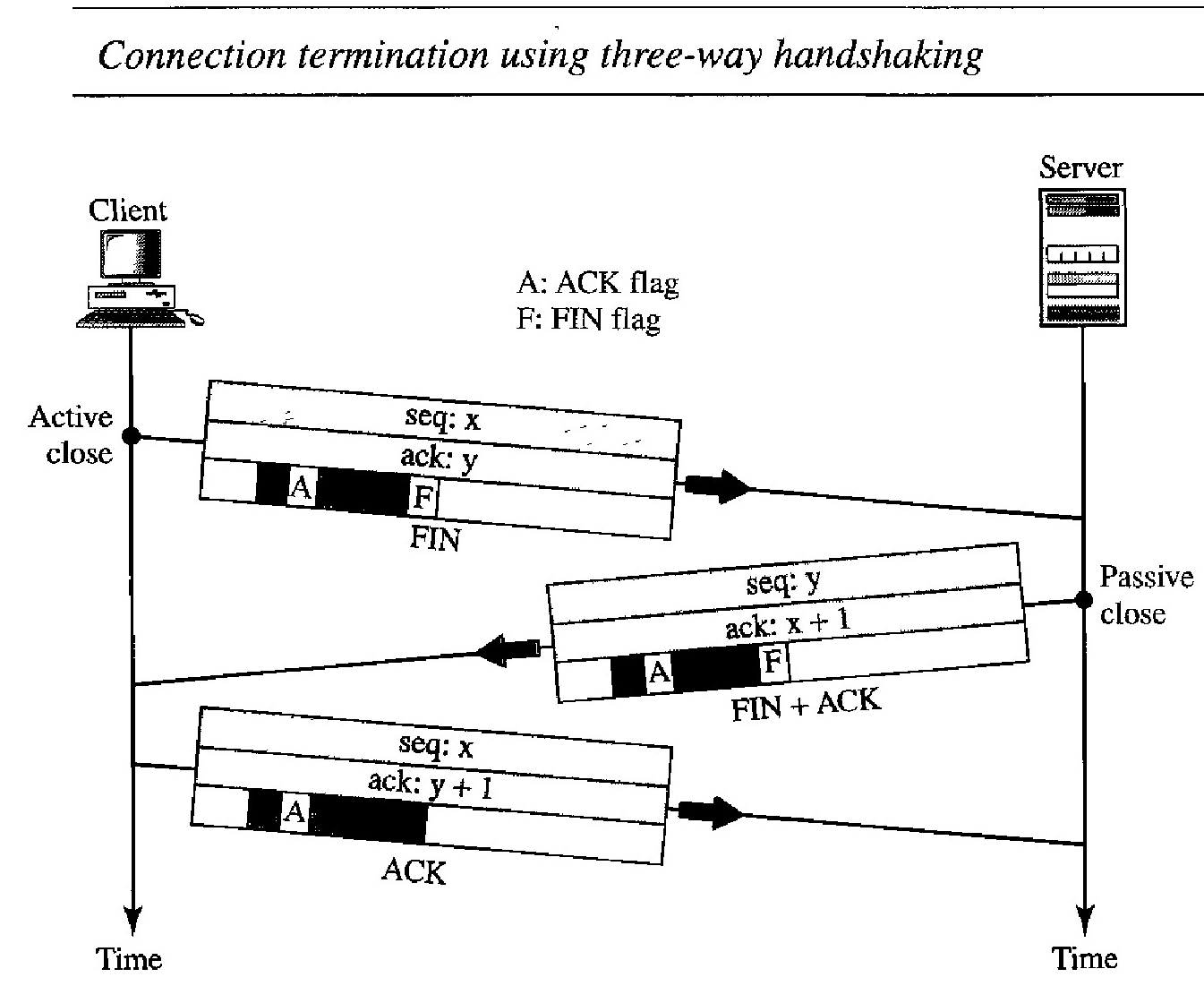
Half-Close
In TCP, one end can stop sending data while still receiving data. This is called a half-close. Although either end can issue a half-close, it is normally initiated by the client.
It can occur when the server needs aU the data before processing can begin. A good example is sorting. When the client sends data to the server to be sorted, the server needs to receive all the data before sorting can start.
This means the client, after sending all the data, can close the connection in the outbound direction. However, the inbound direction must remain open to receive the sorted data. The server, after receiving the data, still needs time for sorting; its outbound direction must remain open.
The client half-closes the connection by sending a FIN segment. The server accepts the half-close by sending the ACK segment. The data transfer from the client to the server stops. The server, however, can still send data. When the server has sent all the processed data, it sends a FIN segment, which is acknowledged by an ACK from the client.
After half-closing of the connection, data can travel from the server to the client and acknowledgments can travel from the client to the server. The client cannot send any more data to the server. Note the sequence numbers we have used.
The second segment (ACK) consumes no sequence number. Although the client has received sequence number y - 1 and is expecting y, the server sequence number is still y - 1.
When the connection finally closes, the sequence number of the last ACK segment is still x, because no sequence numbers are consumed during data transfer in that direction.
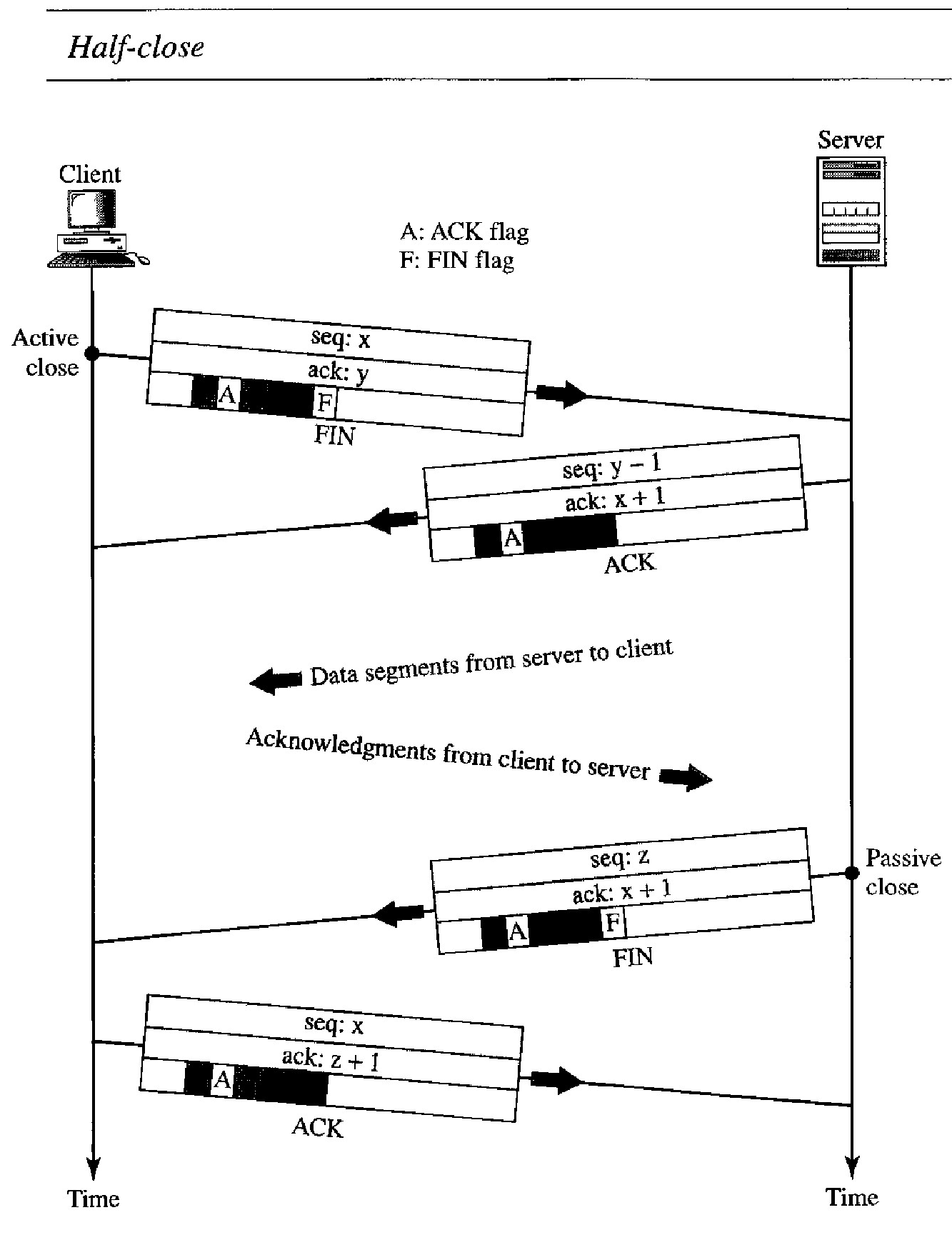
TCP Flow Control
TCP uses a sliding window to handle flow control. The sliding window protocol used by TCP, however, is something between the Go-Back-N and Selective Repeat sliding window.
The sliding window protocol in TCP looks like the Go-Back-N protocol because it does not use NAKs; it looks like Selective Repeat because the receiver holds the out-of-order segments until the missing ones arrive.
There are two big differences between this sliding window and the one we used at the data link layer. First, the sliding window of TCP is byte-oriented; the one we discussed in the data link layer is frame-oriented. Second, the TCP's sliding window is of variable size; the one we discussed in the data link layer was of fixed size.
Figure above shows the sliding window in TCP. The window spans a portion of the buffer containing bytes received from the process. The bytes inside the window are the bytes that can be in transit; they can be sent without worrying about acknowledgment. The imaginary window has two walls: one left and one right.
The window is opened, closed, or shrunk. These three activities are in the control of the receiver (and depend on congestion in the network), not the sender. The sender must obey the commands of the receiver in this matter.
Opening a window means moving the right wall to the right. This allows more new bytes in the buffer that are eligible for sending. Closing the window means moving the left wall to the right. This means that some bytes have been acknowledged and the sender need not worry about them anymore.
Shrinking the window means moving the right wall to the left. This is strongly discouraged and not allowed in some implementations because it means revoking the eligibility of some bytes for sending. This is a problem if the sender has already sent these bytes. Note that the left wall cannot move to the left because this would revoke some of the previously sent acknowledgments.
The size of the window at one end is determined by the lesser of two values: receiver window (rwnd) or congestion window (cwnd). The receiver window is the value adver- tised by the opposite end in a segment containing acknowledgment. It is the number of bytes the other end can accept before its buffer overflows and data are discarded. The congestion window is a value determined by the network to avoid congestion.
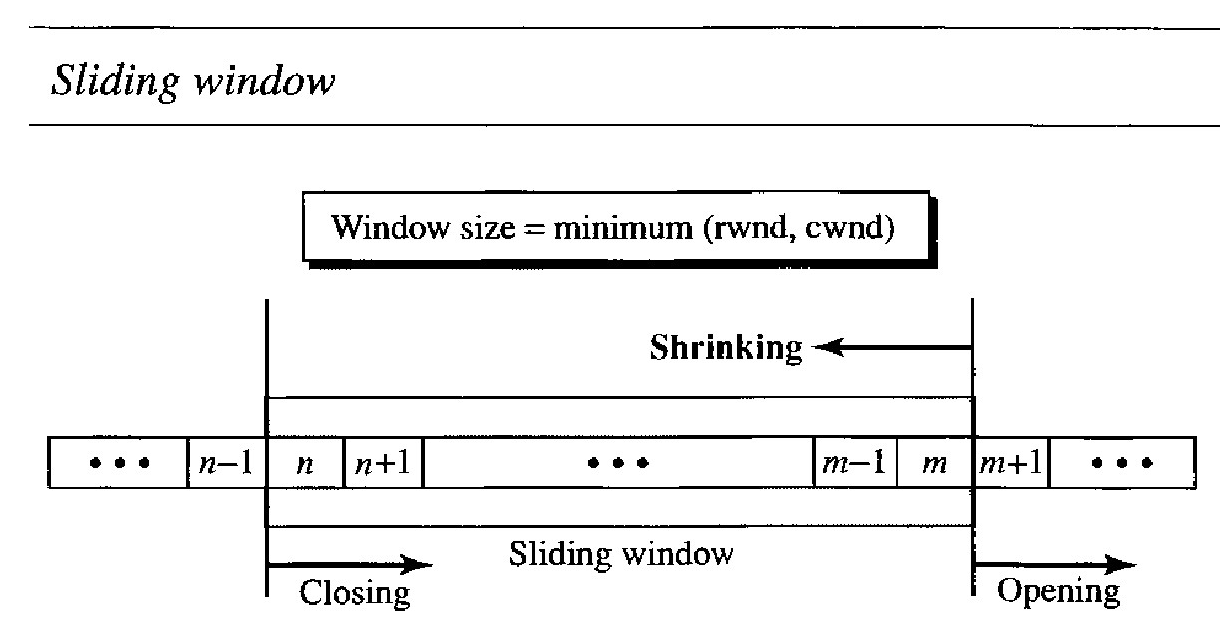
Solved Examples :
Q. What is the value of the receiver window (rwnd) for host A if the receiver, host B, has a buffer size of 5000 bytes and 1000 bytes of received and unprocessed data?
The value of rwnd = 5000 - 1000 = 4000. Host B can receive only 4000 bytes of data before overflowing its buffer. Host B advertises this value in its next segment to A.
Q. What is the size of the window for host A if the value of rwnd is 3000 bytes and the value of cwnd is 3500 bytes?
The size of the window is the smaller of rwnd and cwnd, which is 3000 bytes.
Q. Figure below shows an unrealistic example of a sliding window.
The sender has sent bytes up to 202. We assume that cwnd is 20 (in reality this value is thousands of bytes). The receiver has sent an acknowledgment number of 200 with an rwnd of 9 bytes (in reality this value is thousands of bytes).
The size of the sender window is the minimum of rwnd and cwnd, or 9 bytes. Bytes 200 to 202 are sent, but not acknowledged.
Bytes 203 to 208 can be sent without worrying about acknowledgment. Bytes 209 and above cannot be sent.
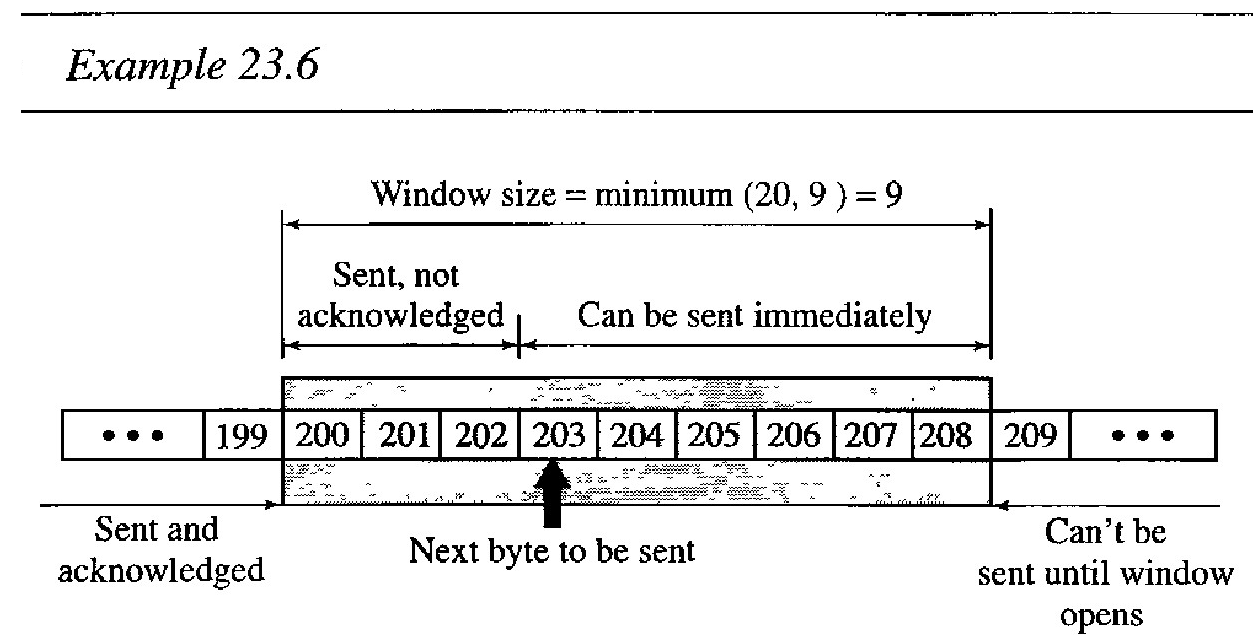
Points to Remember about TCP sliding windows:
The size of the window is the lesser of rwnd and cwnd
The source does not have to send a full window's worth of data
The window can be opened or closed by the receiver, but should not be shrunk.
The destination can send an acknowledgment at any time as long as it does not result in a shrinking window. The receiver can temporarily shut down the window; the sender, however, can always send a segment of 1 byte after the window is shut down.